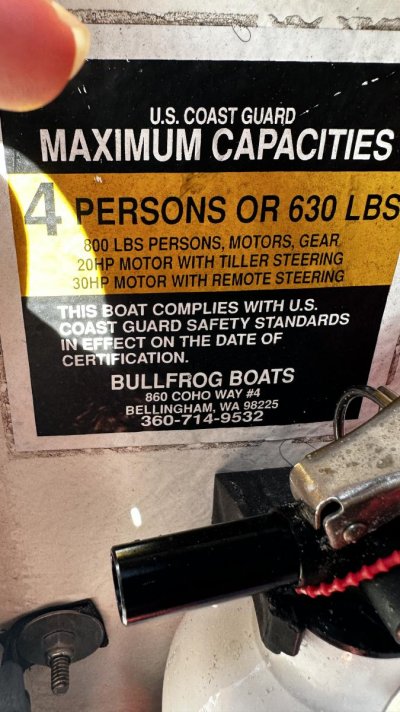Wdeertz
Senior Member
The boat I purchased came with a 2008 11.5’ Bullfrog tender (http://www.bullfrogboats.com/utility-yacht-tender-11_5.html). I really like this tender as it’s a tank and almost indestructible/unsinkable. Other than some cosmetic scratches in the polymer collars and slight blemishes in the stainless rails the boats in really good shape for being 15 years old. I challenge any inflatable to provide such longevity.
I’m thinking of replacing the tender with a new model purely to have something more “aesthetically pretty” and also an outboard with EFI. My current tender has a USCG capacity tag of 4 persons/630 lbs with max 30HP. While looking at the website for the current model it list capacity at 3 person/391 lbs. I reached out to the manufacturer and they confirmed the current model is 100% the same as my 2008 model. He said they recently went through a USCG certification and these were the figures provided. He couldn’t explain the different ratings between my 2008 model and the current model.
Does anyone have any insights as to how these capacity ratings are determined? Has there been a significant change in the standards from 2008 that would explain the difference?
I’ve had 4 adults in my current tender and was probably about 700lbs and the tender handled fine. I’ve seen similar sized inflatables with a rated capacity of 6 people/1400lbs.
I’m thinking of replacing the tender with a new model purely to have something more “aesthetically pretty” and also an outboard with EFI. My current tender has a USCG capacity tag of 4 persons/630 lbs with max 30HP. While looking at the website for the current model it list capacity at 3 person/391 lbs. I reached out to the manufacturer and they confirmed the current model is 100% the same as my 2008 model. He said they recently went through a USCG certification and these were the figures provided. He couldn’t explain the different ratings between my 2008 model and the current model.
Does anyone have any insights as to how these capacity ratings are determined? Has there been a significant change in the standards from 2008 that would explain the difference?
I’ve had 4 adults in my current tender and was probably about 700lbs and the tender handled fine. I’ve seen similar sized inflatables with a rated capacity of 6 people/1400lbs.

